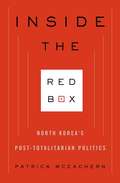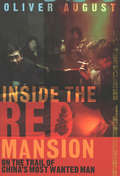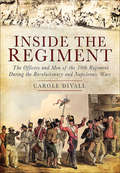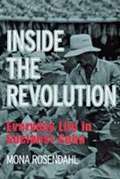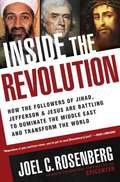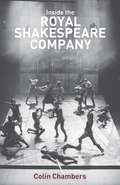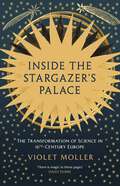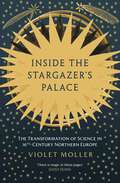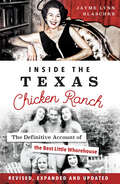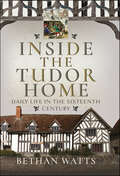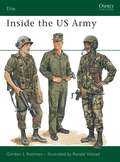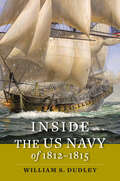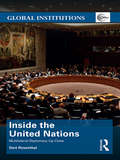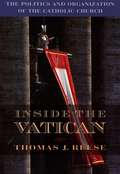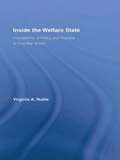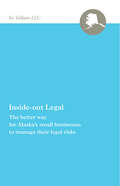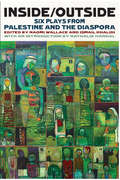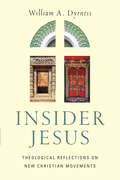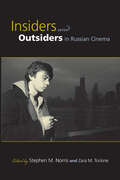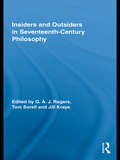- Table View
- List View
Inside the Red Box: North Korea's Post-totalitarian Politics
by Patrick MceachernTraditional political models fail to account for North Korea's institutional politics, making the country's actions seem surprising or confusing when, in fact, they often conform to the regime's own logic. Drawing on recent primary materials, including North Korean speeches, commentaries, and articles, Patrick McEachern, a specialist on North Korean affairs, reveals how the state's political institutions debate policy and inform and execute strategic-level decisions. Many scholars dismiss Kim Jong-Il's regime as a "one-man dictatorship" and call him the "last totalitarian leader," but McEachern identifies three major institutions that help maintain regime continuity: the cabinet, the military, and the party. These groups hold different institutional policy platforms and debate high-level policy options both before and after Kim and his senior leadership make their final call. This method of rule may challenge expectations, but North Korea does not follow a classically totalitarian, personalistic, or corporatist model. Rather than being monolithic, McEachern argues, the regime, emerging from the crises of the 1990s, rules differently today than it did under Kim's father, Kim Il Sung. The son is less powerful and pits institutions against one another in a strategy of divide and rule. His leadership is fundamentally different: it is "post-totalitarian." Authority may be centralized, but power remains diffuse. McEachern maps this process in great detail, supplying vital perspective on North Korea's reactive policy choices, which continue to bewilder the West., reviewing a previous edition or volume
Inside the Red Box: North Korea's Post-totalitarian Politics (Contemporary Asia in the World)
by Patrick McEachernNorth Korea's institutional politics defy traditional political models, making the country's actions seem surprising or confusing when, in fact, they often conform to the regime's own logic. Drawing on recent materials, such as North Korean speeches, commentaries, and articles, Patrick McEachern, a specialist on North Korean affairs, reveals how the state's political institutions debate policy and inform and execute strategic-level decisions.Many scholars dismiss Kim Jong-Il's regime as a "one-man dictatorship," calling him the "last totalitarian leader," but McEachern identifies three major institutions that help maintain regime continuity: the cabinet, the military, and the party. These groups hold different institutional policy platforms and debate high-level policy options both before and after Kim and his senior leadership make their final call. This method of rule may challenge expectations, but North Korea does not follow a classically totalitarian, personalistic, or corporatist model. Rather than being monolithic, McEachern argues, the regime, emerging from the crises of the 1990s, rules differently today than it did under Kim's father, Kim Il Sung. The son is less powerful and pits institutions against one another in a strategy of divide and rule. His leadership is fundamentally different: it is "post-totalitarian." Authority may be centralized, but power remains diffuse. McEachern maps this process in great detail, supplying vital perspective on North Korea's reactive policy choices, which continue to bewilder the West.
Inside the Red Mansion: On the Trail of China's Most Wanted Man
by Oliver AugustA journalist meets fascinating characters while seeking out a fugitive gangster in the Chinese underworld.The notorious gangster Lai Changxing started out as an illiterate farmer, but in the tumult of China’s burgeoning economy, he seized the opportunity to remake himself as a bandit king. A newly minted billionaire of outsized personality and even greater appetites, he was a living legend who eventually ran afoul of authorities. The journalist Oliver August set out to find the fugitive Lai. On his quest he encountered a highly entertaining series of criminals and oddball entrepreneurs—and acquired unique insight into the paradoxes of modern China. Part crime caper, part travelogue, part trenchant cultural analysis, August’s page-turning account captures China’s giddy vibe and its darker vulnerabilities.Praise for Inside the Red Mansion“A year before “Inside the Red Mansion” was due to be published, a handler from the Chinese Foreign Ministry told August that he had enjoyed the book. You needn’t be a spy to agree.” —Janet Maslin, New York Times“A harrowing, super-detailed story of a China exploding with runaway growth yet still trapped in the past and ruled by the ethos of tufei—the classical Mandarin word for bandit . . . . This must-read, can’t-put-it down tale shows the China only hinted at on the evening news—a place of outsized egos, over-the-top commercial development and shadowy, tradition-bound authoritarian rule.” —Publishers Weekly
Inside the Regiment: The Officers and Men of the 30th Regiment During the Revolutionary and Napoleonic Wars
by Carole DivallIn this companion volume to her pioneering study Redcoats Against Napoleon, Carole Divall tells the fascinating inside story of a typical infantry regiment during the Revolutionary and Napoleonic wars. Rather than focusing on the history of the 30th Regiment of the Line in action and on campaign, she explores its organization, traditions and hierarchy, its personnel, and the ethos that held it together. Using primary source material, in particular surviving regimental records, War Office documents, letters and journals, Divall reconstructs the life of the 30th Foot – and the lives of the men who served in it – during a critical period in Europes military history.
Inside the Revolution: Everyday Life in Socialist Cuba
by Mona RosendahlInside the Revolution offers a rare, close view of how socialist ideology translates into everyday experience in one Cuban municipality. Mona Rosendahl draws on eighteen months of fieldwork, in a municipality she calls by the fictional name Palmera, to present a vivid account of the lives and thoughts of residents, many of whom have lived inside the revolution for more than thirty-five years.
Inside the Revolution: How the Followers of Jihad, Jefferson & Jesus Are Battling to Dominate the Middle East and Transform the World
by Joel C. RosenbergInside the Revolution takes you inside the winner-take-all battle for the hearts, minds, and souls of the people of the Middle East. It includes never-before-seen profiles of the Radicals, the Reformers and the Revivalists. It explains the implications of each movement and the importance of each leader, not only through the lenses of politics and economics but through the third lens of Scripture as well. Today, wars and revolutions define the modern Middle East, and many believe the worst is yet to come. How real and serious is the threat of Radical Islam to American national security eight years after 9/11? Are there any Muslim leaders who oppose the violence of the Radicals--and is there any hope that such leaders will come to power in key countries in the Middle East? What is God doing in the Middle East--and is there any hope that Muslims will find faith in Jesus Christ? How can we as Christians help strengthen our brothers and sisters who love Jesus in the Muslim world, and how can we reach out to Muslims here at home?
Inside the Royal Shakespeare Company: Creativity and the Institution
by Colin ChambersThis is the inside story of the Royal Shakespeare Company - a running historical critique of a major national institution and its location within British culture, as related by a writer who is uniquely placed to tell the tale. It describes what happened to a radical theatrical vision and explores British society's inability to sustain that vision. Spanning four decades and four artistic directors, Inside the Royal Shakespeare Company is a multi-layered chronicle that traces the company's history, offers investigation into its working methods, its repertoire, its people and its politics, and considers what the future holds for this bastion of high culture now in crisis. Inside the Royal Shakespeare Company is compelling reading for anyone who wishes to explore behind the scenes and consider the changing role of theatre in modern cultural life. It offers a timely analysis of the fight for creative expression within any artistic or cultural organisation, and a vital document of our times.
Inside the Stargazer's Palace: The Transformation of Science in 16th-Century Europe
by Violet MollerEnter the mysterious world of sixteenth-century science, where astronomers and alchemists shared laboratories.In 1543, Nicolaus Copernicus declared the earth revolved around the Sun, overturning centuries of scholastic presumption. A new age was coming into view – one guided by observation, technology and logic. But omens and elixirs did not disappear from the sixteenth-century laboratory. Charms and potions could still be found nestled between glistening brass instruments and leather-bound tomes. The line between the natural and supernatural remained porous, yet to be defined. From the icy Danish observatory of Tycho Brahe, to the smoky, sulphur-stained workshop of John Dee, Violet Moller tours the intellectual heart of early European science. Exploring its rich, multidisciplinary culture, Inside the Stargazer&’s Palace reveals a dazzling forgotten world, where all knowledge, no matter how arcane, could be pursued in good faith.
Inside the Stargazer's Palace: The Transformation of Science in 16th-Century Northern Europe
by Violet MollerEnter the mysterious world of sixteenth-century science, where astronomers and alchemists shared laboratories... 'There is magic in these pages.' Daisy Dunn, author of The Missing Thread In 1543, Nicolaus Copernicus declared the earth revolved around the Sun, overturning centuries of scholastic presumption. A new age was coming into view – one guided by observation, technology and logic. But omens and elixirs did not disappear from the sixteenth-century laboratory. Charms and potions could still be found nestled between glistening brass instruments and leather-bound tomes. The line between the natural and supernatural remained porous, yet to be defined. From the icy Danish observatory of Tycho Brahe, to the smoky, sulphur-stained workshop of John Dee, Violet Moller tours the intellectual heart of early European science. Exploring its rich, multidisciplinary culture, Inside the Stargazer&’s Palace reveals a dazzling forgotten world, where all knowledge, no matter how arcane, could be pursued in good faith. *** 'In this fascinating study of the early scientific revolution, when experimental thought was beginning to emerge from Medieval scholasticism, Violet Moller brings to life the trailblazers of this new age.' Paul Strathern, author of The Other Renaissance 'Inside the Stargazer's Palace plunges us into an irresistible network of touchy scientists, unpredictable patrons and religious controversy in the sixteenth century, antechamber of the modern world. Violet Moller is an assured and expert guide to this world, writing with a light touch and an infectious love of her subject.' Christopher de Bellaigue, author of The Lion House &‘Inside the Stargazer&’s Palace takes the reader to places they are unlikely to have visited and to figures they are unlikely to know… Violet Moller brings the world to life vividly and with style.&’ Nicholas Spencer, author Magisteria
Inside the Texas Chicken Ranch: The Definitive Account of the Best Little Whorehouse (Landmarks)
by Jayme Lynn BlaschkeThanks to the classic Dolly Parton film The Best Little Whorehouse in Texas and ZZ Top's ode "La Grange," many people think they know the story of the infamous Chicken Ranch. The reality is more complex, lying somewhere between heartbreaking and absurd. For more than a century, dirt farmers and big-cigar politicians alike rubbed shoulders at the Chicken Ranch, operated openly under the sheriff's watchful eye. Madam Edna Milton and her girls ran a tight, discreet ship that the God-fearing people of La Grange tolerated if not outright embraced. That is, until a secret conspiracy enlisted an opportunistic reporter to bring it all crashing down on primetime television. Drawn from exclusive interviews and expanded with newly uncovered information, Jayme Lynn Blaschke's revelatory exposition of the Ranch illuminates the truth and lies surrounding this iconic brothel.
Inside the Third Reich
by Clara Winston Richard Winston Albert SpeerSpeer, the Minister of Armaments and War Production under Hitler, the man who had kept Germany armed and the war machine running even after Hitler's mystique had faded, takes a brutally honest look at his role in the war effort.
Inside the Tudor Home: Daily Life in the Sixteenth Century
by Bethan WattsInside the Tudor Home sheds light on how people lived in the sixteenth century from plush royal palaces to wattle-and-daub cottages and everything in between. Power. Politics. Prosperity. Plague. Tudor England; a country replete with sprawling landscapes, dense forests and twisting urban labyrinths. This is a place of stagnation and of progress; of glorious cultural revolution, where the wheel of fortune is forever turning. From the plush royal palaces to the draughtiest of wattle-and-daub cottages, sixteenth-century England revolved around the people who formed the beating heart of Tudor society. These people celebrated scientific progress and lamented religious persecution; championed the rights of women and the underrepresented; fell in love with sweethearts, cared for pets and mourned the deaths of their loved ones. In her first book, Bethan Catherine Watts sheds light on the Tudor home and the everyday lives of those who lived there.
Inside the US Army
by Gordon Rottman Ronald VolstadWhen conscription was eliminated in the early 1970s, the US Army found itself with a very different kind of soldier. While the personality of the Army remained the same, the organization of its higher levels of command and combat formations, and the internal structure of its units underwent major changes under the 'Army of Excellence' program of the 1980s. This book explores the US Army of the late 80s, including the training methods, weapon systems, Reserve Components, organization and uniforms of one of the world's most potent fighting forces. The text is illustrated with numerous photographs and eight colour plates.
Inside the US Navy of 1812–1815 (Johns Hopkins Books on the War of 1812)
by William S. DudleyWhat did it take—logistically and operationally—for the small and underfunded US Navy to face the battle-hardened Royal Navy in the War of 1812? Find out in this book, the magnum opus of one of the deans of American naval history.When the War of 1812 broke out, the newly formed and cash-strapped United States faced Great Britain, the world's foremost sea power, with a navy that had largely fallen into disrepair and neglect. In this riveting book, William S. Dudley presents the most complete history of the inner workings of the US Navy Department during the conflict, which lasted until 1815. What did it take, he asks, for the US Navy to build, fit-out, man, provision, and send fighting ships to sea for extended periods of time during the War of 1812?When the British blockade of 1813–14 severely constrained American sea trade, reducing the government's income and closing down access to American seaports, the navy was forced to innovate: to make improvements through reforms, to redeploy personnel, and to strengthen its industrial capacity. Highlighting matters of supply, construction, recruitment, discipline, medical care, shipbuilding, and innovation, Dudley helps readers understand the navy's successes and failures in the war and beyond. He also presents the logistics of the war in relation to fleet actions on the lakes and selected ship actions on the oceans, stresses the importance of administration in warfighting, and shows how reforms and innovations in those areas led to a stronger, more efficient navy. Refuting the idea that the United States "won" the war, Dudley argues that the conflict was at best a stalemate. Drawing on twenty-five years of archival research around the world, Inside the US Navy of 1812–1815 will leave readers with a better appreciation of how the navy contributed strategic value to the nation's survival in the conflict and assisted in bringing the war to an honorable end. This book will appeal to scholars and students of naval and military history, veterans, current officers, and maritime-oriented history buffs.
Inside the United Nations: Multilateral Diplomacy Up Close (Global Institutions)
by Gert RosenthalInside the United Nations illustrates some of the parameters surrounding consensus-building at the United Nations, seeking to provide new insights beyond what is already known. The author spent twelve years as P.R of Guatemala at the UN, offering him privileged observatories in all three of the main inter-governmental organs: the General Assembly, the Economic and Social Council, and the Security Council. In this book Rosenthal focuses on six case studies that offer the breadth and scope of what the UN does, and illustrate some of the main elements of the dynamics of consensus-building, providing concrete examples of the ingredients that shape decision-making in a multilateral setting. The chapters: cover the origin, preparation, and outcome of two successful international conferences: the 2000 Millennium Summit and the 2002 International Conference on Financing for Development; look at the 2000 negotiation on the scale of assessments to finance the UN’s budget in the General Assembly’s fifth committee (2000-2001); focus on the relevance of the Economic and Social Council; consider the internal politics involved in vying for elected posts in intergovernmental bodies by focusing on the campaign to be elected to the Security Council between Guatemala and Venezuela in 2006; reflect on the peculiarities of decision-making in the Security Council. Providing an insider’s view on the UN and exploring different facets of multilateral diplomacy at the UN, this book will be of great use and interest to scholars of international relations as well as the diplomatic community.
Inside the VC and the NVA: The Real Story of North Vietnam's Armed Forces
by Michael Lee LanningIf the costs of the Vietnam War were great to Americans and staggering to the South Vietnamese, they were even worse for the North. And those costs were borne largely by the individual soldiers—the soldiers who won the war.<P> Based on interviews, soldiers’ diaries, letters, and government documents, this book, first published in 1992, gives a classic, soldier’s-eye account of the war our opponents fought and the men who fought it.
Inside the Vatican of Pius XII: The Memoir of an American Diplomat During World War II
by Harold H. Tittmann IIIAn invaluable contribution to the history of the Catholic Church during the Second World War, this is a richly detailed eyewitness account of the life and politics of the Vatican by an American who worked there from 1940 to 1944. The question of whether Pius XII and the Vatican must bear blame for failing to act decisively in response to Hitler's Final Solution is as hotly debated today as in the years directly following World War II. INSIDE THE VATICAN OF PIUS XII presents for the first time the obse...
Inside the Vatican: The Politics and Organization of the Catholic Church
by Thomas S.J. ReeseA comprehensive examination of the world’s most complex religious organization.There are one billion Catholics in the world today, spread over every continent, speaking almost every conceivable language, and all answering to a single authority. The Vatican is a unique international organization, both in terms of its extraordinary power and influence, and in terms of its endurance. Popes come and go, but the elaborate and complex bureaucracy called the Vatican lives on. For centuries, it has served and sometimes undermined popes; it has been praised and blamed for the actions of the pope and for the state of the church. Yet an objective examination of the workings of the Vatican has been unavailable until now.Drawing on more than a hundred interviews with Vatican officials, this book affords a firsthand look at the people, the politics, and the organization behind the institution. Thomas Reese brings remarkable clarity to the almost Byzantine bureaucracy of congregations, agencies, secretariats, tribunals, nunciature, and offices, showing how they serve the pope and, through him, the universal church. He gives a lively account of how popes are elected and bishops appointed, how dissident theologians are disciplined and civil authorities dealt with. Throughout, revealing and colorful anecdotes from church history and the present day bring the unique culture of the Vatican to life.The Vatican is a fascinating institution, a model of continuity and adaptation, which remains constant while functioning powerfully in a changing world. As never before, this book provides a clear, objective perspective on how the enormously complex institution surrounding the papacy operates on a day-to-day level, how it has adapted and endured for close to two thousand years, and how it is likely to face the challenges of the next millennium.Praise for Inside the Vatican“Reese does an admirable job of lifting the veil of secrecy surrounding the Holy See to examine the nuts and bolts of the operation . . . [He] paints a revealingly human portrait of Vatican life . . . Ultimately, this is the merit of Inside the Vatican: Reese gets it right. And in [such] a place . . . that’s no easy task.” —Greg Burke, Time“[Reese] paints a clear, largely dispassionate and often compelling picture of Vatican operations and, in so doing, highlights the tensions that tear the church.” —Diego Ribadeneira, The Boston Globe“[T]his is a useful and even valuable study of the institutional centre of the Roman Catholic Church, and of the relations between the centre, and the worldwide network of local churches which go to make up the Church catholic. Dr. Reese . . . brings impressive qualifications and experience as a political scientist to this [study] . . . It is the special virtue of Dr. Reese’s study that he succeeds where many have failed in providing an analytic, critical and comprehensive account of how [the Vatican] works.” —Seán Mac Réamoinn, The Irish Times
Inside the Welfare State: Foundations of Policy and Practice in Post-War Britain (British Politics and Society)
by Virginia NobleBy moving beyond consideration of the welfare legislation enacted in the 1940s, this book explains how government aid was actually provided in the new British welfare state created just after World War II. Revealing dimensions of social policy that have been neglected by scholars, this study uncovers the practices of the officials who decided how welfare would be distributed. Between 1945 and 1965, social policy was in a state of flux, as officials sought to reconcile the new welfare state’s message of unqualified inclusion with deeply ingrained norms that militated against providing state aid to working-age men, to women who had even a tenuous connection to a male wage-earner, or to black and Asian immigrants who lacked an authentic "British" identity. Fusing the rationales of the poor law and the technologies of the modern bureaucratic state, various government branches tried to shape the behavior and attitudes of those seeking benefits. These mechanisms of welfare distribution created a bureaucratic language and logic that foreshadowed the more publicized, politicized anxieties that would surface as the welfare state itself came under attack later in the 20th century.
Inside the Wire: A Military Intelligence Soldier's Eyewitness Account of Life at Guantanamo
by Erik Saar Viveca NovakDescribes in vivid detail the conditions and treatment.
Inside-out Legal: The better way for Alaska’s small businesses to manage their legal risks
by Andrew MittonVellum LLC is a new kind of law firm dedicated to designing legal tools and providing legal services that help Alaska's small business owners fulfill their professional calling in life. Inside-out Legal Services is the way it accomplishes this goal.
Inside/Outside
by Naomi Wallace Nathalie Handal Ismail KhalidiDue to the enormous--and ever-growing--interest in Palestinian plays around the world, Inside/Outside brings together six dynamic Palestinian playwrights from both Occupied Palestine and the Diaspora, making it the very first collection of its kind. These plays take on Palestinian history and culture with irreverence, humor, and, above all, an electrifying creativity. This anthology will be a vital contribution to world theater, introducing six political, social, and culturally relevant plays by Palestinian authors living inside the country, and those of descent living outside: Handala adapted by Abdelfattah Abusrour; 603 by Imad Farajin; Keffiyeh/Made in China by Dalia Taha; Plan D by Hannah Khalil; Tennis in Nablus by Ismail Khalidi; and Territories by Betty Shamieh.Naomi Wallace's award-winning plays, which include One Flea Spare and The Fever Chart, are produced in the United States and around the world. Wallace is a recipient of an Obie Award, the MacArthur Fellowship, and the inaugural Windham Campbell prize for drama in 2013.Ismail Khalidi is a playwright and poet. His plays include Tennis in Nablus, Truth Serum Blues, and Sabra Falling.
Insider Jesus: Theological Reflections on New Christian Movements
by William A. DyrnessChristianity Today's 2017 Book of the Year Award of Merit - Missions/Global Church
Insiders and Outsiders in Russian Cinema
by Stephen M. Norris Zara M. TorloneIdentifying who was "inside" and who was "outside" the Soviet/Russian body politic has been a matter of intense and violent urgency, especially in the high Stalinist and post-Soviet periods. It is a theme encountered prominently in film. Employing a range of interpretive methods practiced in Russian/Soviet film studies, Insiders and Outsiders in Russian Cinema highlights the varied ways that Russian and Soviet cinema constructed otherness and foreignness. While the essays explore the "us versus them" binary well known to students of Russian culture and the ways in which Russian films depicted these distinctions, the book demonstrates just how impossible maintaining this binary proved to be.Contributors are Anthony Anemone, Julian Graffy, Peter Kenez, Joan Neuberger, Stephen M. Norris, Oleg Sulkin, Yuri Tsivian, Emma Widdis, and Josephine Woll.
Insiders and Outsiders in Seventeenth-Century Philosophy (Routledge Studies in Seventeenth-Century Philosophy)
by Tom Sorell Jill Kraye G. A. J. RogersSeventeenth-century philosophy scholars come together in this volume to address the Insiders--Descartes, Spinoza, Leibniz, Locke, and Hobbes--and Outsiders--Pierre Gassendi, Kenelm Digby, Theophilus Gale, Ralph Cudworth and Nicholas Malebranche--of the philosocial canon, and the ways in which reputations are created and confirmed. In their own day, these ten figures were all considered to be thinkers of substantial repute, and it took some time for the Insiders to come to be regarded as major and original philosophers. Today these Insiders all feature in the syllabi of most history of philosophy courses taught in western universities, and the papers in this collection, contrasting the stories of their receptions with those of the Outsiders, give an insight into the history of philosophy which is generally overlooked.
